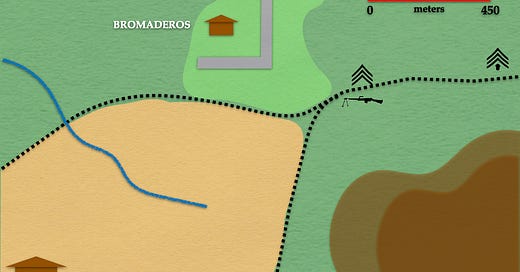Written by Lieutenant Harold D. Harris, USMC, this exercise appeared in Volume XI (January 1936) of the Infantry School Mailing List and Volume 21, Number 11 (November 1938) of The Leatherneck.
This is the fourth problem in the exercise. If you have not done so already, you will probably want to begin at the beginning.
The sergeant applied the first step of immediate action. He took the rifle, tapped the magazine into position, pulled back and then pushed forward the operating handle, aimed, and opened fire.
DISCUSSION
Immediate action is the unhesitating application of a probable remedy for a stoppage. The sergeant applied the first step in case of any stoppage. It will reduce practically 90 per cent of those that occur. If the automatic rifleman had been so trained that he would mechanically, without thought, perform the first step of immediate action, a considerable number of bandits would have been wiped out.
Unfortunately the group of Sandinistas had begun to disperse when the sergeant opened fire and he succeeded in wounding only two. The entire group dived to cover . behind the stone wall. Soon the sergeant and auto-rifleman were under machine-gun fire from behind the stone wall and rifle fire from the heights. But the bandits were unable to see them and fired only in the general direction of the automatic rifle fire.
Fortunately neither of the two men was hit, but they decided it was too hot to remain long in that area. Both the sergeant and private worked their way some distance to the rear, crossed to the south side of the trail and moved westward. Finally the sergeant gathered together all of the second squad and the two survivors of the advance-guard squad. They then made a concerted effort to drive forward toward the cornfield but the bandit fire and occasional bombs stopped the attempt.
After two more men were wounded, the sergeant abandoned his plan to join the lieutenant, and withdrew a few hundred yards to the east. He sent word back to the gunnery sergeant, who was the senior, telling him that the lieutenant was cut off from the patrol, that the first squad was practically wiped out, that bandit fire was being received from the front and both flanks, that he (the gunnery sergeant) had better get the patrol together and take over.
The rear-guard squad was still some distance to the rear and halted under cover off the trail. Apparently the bandits were unaware of its presence for it had not entered the fight. The mission of the squad was “to cover the rear of the patrol in case of trouble.”
REQUIREMENT
You are the sergeant. What are your orders and actions?
This exercise serves neither as an argument for particular courses of action nor a criticism of decisions made in specific circumstances. Rather, it exists to give participants opportunities to immerse themselves in problems faced by a real person at some point in the past, and, in doing so, cultivate such martial virtues as decisiveness, critical thinking, creativity, situational awareness, and functional empathy.
The next step in this exercise is the presentation of the historical solution, which will be posted shortly. If you wish to reap full benefit from this decision-forcing case, please refrain from reading the historical solution until you have come to a decision.
Please feel free to use the comment section to describe your solution to this problem. In doing this, please take care to avoid any information that would spoil the problem for your fellow readers.





